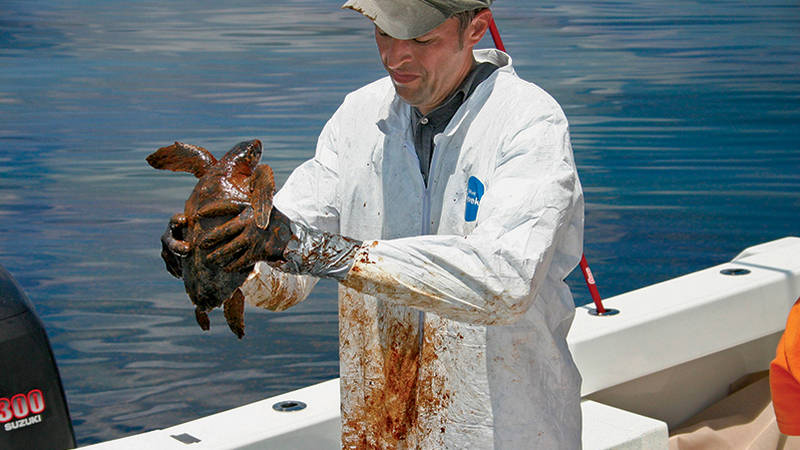Winter 2018
Waiting for a Baby Boom
Are decades of work to save Kemp’s ridley sea turtles paying off yet?
It’s a windy May morning on the Texas coast, and dancing sand nips my ankles as I cross an expanse of beach. I’m at Padre Island National Seashore to learn about rare Kemp’s ridley sea turtles, and as I walk to the park headquarters, I can’t help but study the landscape for signs of the turtles. I don’t see any, but the wind, I will find out a few minutes later, is a very good sign that I might get to see what I’ve been hoping for: nesting Kemp’s ridleys, coming ashore to bury their eggs in the sand.
“This could be a big, big day,” Donna Shaver tells me when I get inside. “This could be the kind of day we wait all year for.”
For Shaver, who’s been leading the park’s sea turtle program for more than three decades, a big day means dozens of turtles nesting along the Texas coast. It turns out that Shaver is right. By the day’s end, turtle watchers spot 19 Kemp’s ridley nests along the 70-mile stretch of undeveloped barrier island that makes up the national park and find an additional 11 nests at nearby beaches.
Kemp’s ridleys are the smallest and most endangered sea turtles in the world. Researchers estimate that in the 1940s, about 50,000 females laid eggs in more than 120,000 nests along the Gulf of Mexico each year. Possibly to limit the impact of predators, thousands of turtles would swarm a beach at once — a phenomenon known as “arribada.” But decades of poaching both the turtles and their eggs took their toll on the species. At one point in the 1980s, fewer than 250 females were nesting in Mexico, and almost none on the Texas coast where the turtle had historically nested.
In 1978, the U.S. and Mexico joined forces to re-establish Padre Island as a nesting colony that would be a backup to Rancho Nuevo, Mexico, by then the only large nesting site for the species. Over the course of 10 years, scientists collected thousands of eggs from Rancho Nuevo and released the hatchlings onto the beach at Padre Island with the hope that the turtles would one day return to their birthplace in Texas to nest. In 1996, the first tagged female from the project returned to Padre Island, and, for more than a decade thereafter, the number of nesting turtles grew almost every year. In 2009, Shaver’s team and their collaborators found nearly 200 nests on the Texas coast. At the same time, numbers in Mexico had risen from a few hundred nests a year to more than 20,000 nests, and scientists started to project that the Kemp’s ridley would be downgraded on the endangered species list — from endangered to threatened — by 2020. But then, the turtle population stopped growing, in both Mexico and Texas.
That’s why I’m meeting with Shaver: to talk about this stagnated population growth and what researchers are doing about it. Shaver tells me that fewer new turtles are nesting at Padre Island and that the turtles that were nesting on these beaches aren’t returning as often as they used to. She speculates about some of the factors that might be hurting the population. After the 2010 Deepwater Horizon oil spill, some weak and starving turtles covered in oil washed ashore, and scores of others could have died at sea. Warming oceans, Shaver says, are another likely culprit because they could be affecting the turtles’ food sources — for example, populations of one of the small crabs that these turtles eat have been declining in recent years. And though mandatory devices now help turtles escape fishing nets, other devices designed to reduce bycatch are depriving Kemp’s ridleys of one of their food sources because fishermen are no longer throwing overboard large quantities of unwanted fish. Shaver starts to explain how the turtles could be harmed by expanding dead zones — areas of the ocean where fertilizers and other pollutants stimulate the growth of harmful algae and deplete the waters of oxygen, killing many forms of marine life — when the radio sitting on her desk buzzes to life.
“We’ve got a nest,” says a disjointed voice between bursts of static.
“Copy,” Shaver says. “Great job! Let me know if there’s a tag.”
“A lot of things have to happen very quickly when we find a nest,” she says, apologizing for the interruption in our conversation as she opens a database on her computer. “And when one turtle nests, it’s likely that more will. They all sense the same conditions.”
It’s quickly apparent how immersed Shaver is in this work. She barks commands through the radio while jotting down notes about when and where the nesting turtle was spotted. Her room looks like it’s straight out of a turtle museum. Photos of turtles adorn the walls; turtle figurines, carvings and knick-knacks cover every surface; and the bookshelves are crammed with turtle books and journals. Later, I learn that Shaver, who is 58, sometimes sleeps here so she can monitor turtle eggs overnight. When I ask her whether she has any hobbies, she says, without any hint of a smile, “When I have free time, I write publications to share our results.” (She also admits to spending time with her dogs — which she’s trained to detect the scent of turtle eggs and find hidden nests — and her very supportive husband.)

A scientist holds an oil-covered Kemp’s ridley sea turtle that was recovered shortly after the Deepwater Horizon oil spill in 2010.
© REX FEATURES/AP IMAGESDuring a lull in the radio chatter, Shaver tells me about a group of turtles wearing satellite tags that are expected to nest any day now. It’s one of the reasons she suspects it will be a big day. The steady wind also has her hopes up: Egg-laying turtles favor windy days because the wind hides their scent and tracks from predators. She pulls up on her computer screen a map with dotted lines showing the paths of each tagged animal, which she talks about as if they were old friends.
“Mary Anne is up here right now,” she says, pointing at a spot just off Padre Island. “She nested a few weeks ago.”
Before I can ask Shaver more questions, she says that if I want to see turtles today, I need to join one of the patrols about to head out. So I meet Cynthia Rubio, a wildlife biologist who’s been working here for two decades, and hop into her four-wheel-drive SUV.
As she inches down the beach, wheels plowing through the sand, Rubio’s eyes scan back and forth across the landscape. All day, all summer long, teams of scientists, technicians and volunteers patrol this beach for nesting turtles so they can not only keep a tally but collect and incubate the turtles’ eggs and — about 50 days later — release the hatchlings into the ocean. Like all Texas beaches, Padre Island National Seashore is open to vehicles, and eggs can be crushed by trucks and SUVs, or eaten by predators, if the researchers don’t collect them quickly.
It’s tedious fieldwork: hours of slow driving, staring at the sand. Days — usually hot, windless ones — can go by without a single turtle sighting. (Kemp’s ridleys are the only sea turtles that nest mostly during the day.) A volunteer tells me that it’s easy to get superstitious about finding turtle nests and that some vehicles are considered luckier for spotting nests. I also learn that it’s easy to mistake the zigzags of tire tracks that cover the beach for the trails left behind by turtles. Time and again, Rubio slows down, peering intently at the sand, and I start to get excited. Then she shakes her head.
“Nope, just tracks,” she says.
A few hours pass before I get to see a turtle, and Rubio and I aren’t the ones who initially spot her; we drive up after another patrol team has already reported the nest. Though I missed the excitement of getting there first, I’m mesmerized as I stand 10 feet away, watching her hustle to hide her eggs. Her back flippers rhythmically fling sand into the air, and each time they come down, I feel the powerful thumps reverberate beneath my feet. Before she’s finished her primal dance, I catch a few glimpses of the nearly 100 eggs in her nest, each one glistening white, slightly smaller than a pingpong ball. A few minutes later, she’s lumbering away from her nest. The area of sand, barely even raised, is unremarkable except for a flag that a researcher strategically stuck next to it.
“I still get so excited every time I see this,” Rubio says. “They’re such an ancient animal, and you think about all the effort it’s taken for them to get here and lay these eggs. It’s pretty incredible.”
The only time Kemp’s ridley females come ashore in their entire lives, barring injury or accident, is during the roughly 45 minutes it takes them to nest and lay eggs, so it’s a vital window for researchers who are trying to track, study and — ultimately — save the turtles. “Just to find and document a nest is a small victory,” Shaver had told me that morning.
Scientists are also trying to find out more about male Kemp’s ridleys, an even more elusive population than females because most males, after hatching, don’t come ashore for the rest of their lives. As of this summer, the Padre Island group has tracked six male turtles, all of which were found injured on the beach or had been unintentionally caught by fishermen and later equipped with satellite trackers and released by researchers.
Later that afternoon, when Rubio and I come across our second Kemp’s ridley of the day, I understand better just how much the researchers have to accomplish during their short encounters with the turtles. This turtle, unlike the first one we saw nesting, has never crossed paths with the research team before. As Shaver would put it, she’s a newbie. When she’s ashore, Rubio and a research technician — while trying not to interrupt the turtle’s nesting — inject a scannable marker into her front flipper, clip metal tags onto her flippers, take a small skin biopsy for their genetic database, measure her shell, mark the location of the nest and take dozens of photos. Sometimes, after the turtle is done nesting, they also glue a transmitter or accelerometer to the turtle’s shell, but they’ve already hit their quota for the year — set by resources and budget — so they’re spared that work today. Later in the day, I watch them gently pry an accelerometer off another turtle that’s come ashore; unlike the satellite transmitters that continuously send information back to the team, this battery-sized accelerometer needs to be collected manually for its information to be downloaded.
After Rubio and I watch the turtle meander back to the ocean and disappear under the waves, I ask her why we should save the Kemp’s ridleys at all because they don’t seem to play an outsized role in ocean ecosystems. Rubio cites our collective responsibility. “We have a duty to help this species,” she says. “Humans are the reason they ever declined in the first place.”
The data that Shaver, Rubio and their colleagues gather on each turtle will help give them a sense of the lives of Kemp’s ridleys during the time they’re not nesting: how far they travel, how much time they spend in different areas and how fast they grow, among other measures. Satellite transmitters give information on where the turtles go throughout the year, but accelerometers provide more nuanced details on the animals’ daily lives, such as how deep and how often they dive for food.
“These turtles only spend a small fraction of their life here,” Shaver says. “They spend most of their life out in the ocean, so we want to understand what happens there.”
Shaver’s team analyzed data on 82 turtles outfitted with satellite transmitters and, earlier this year, published the first-ever description of the species’ “inter-nesting” period. The turtles, they found, tend to stay a few miles offshore in a narrow band of water in the Gulf of Mexico. It’s an area where shrimpers trawl and oil companies drill, so defining the habitat is critical to future protection efforts, Shaver says.
In another study published this year, Shaver and her colleagues reported that between 1993 and 2010, Kemp’s ridleys started growing more slowly, their shell sizes increasing by fewer inches per year. This may mean that female turtles are taking longer to reach maturity and start laying eggs. Separately, researchers have found that turtles are nesting less often — every three years instead of every two. These two pieces of data may partially explain why recently there have been fewer nests per year in Texas and Mexico. Until this year, that is. Shaver tells me that early numbers from this nesting season are looking good.
“At this point in the year, I think we may set a new record,” she says. “But what does that mean? Will the numbers go back down next year?”
In mid-June, I visit Padre Island again to see a hatchling release, one of 27 this year. At 6:45 a.m., hundreds of people are ushered toward a patch of sand behind the visitor center. Shaver takes 73 tiny turtles, each smaller than the palm of her hand, out of a box one by one and places them in the sand. The release feels ceremonial; volunteers hold a giant net on poles high above the turtles to protect them from birds as they move toward the water. Visitors, many of them children, crowd around to see the turtles, oohing and aahing and snapping photos. Some hatchlings scurry, others meander, and the first one hits the foamy ocean less than 10 minutes later.
“When these hatchlings are released, that’s our hope for the next generation,” Shaver says. “These are the turtles that will be coming back here in 15 years to nest.”

National Parks
You can read this and other stories about history, nature, culture, art, conservation, travel, science and more in National Parks magazine. Your tax-deductible membership donation of $25 or more entitles…
See more ›I discover later that Shaver’s gut feeling about the annual count was right: By July 15, when daily patrols stop, 353 Kemp’s ridley nests have been found in Texas, crushing the previous state record of 209; 219 of those nests were spotted within the boundaries of the national park. Shaver thinks the relatively warm winter might have caused the spike by giving the turtles a chance to fatten up more before nesting season. Researchers are seeing the same trends with green and loggerhead turtles — other species that nest in Texas — and the Kemp’s ridley’s nesting numbers in Mexico also were higher this year than during the last few years. That’s good news for all the turtles, but it also suggests that the sudden spike in Kemp’s ridley nest numbers may not be entirely the result of the team’s efforts at Padre Island. It could be an anomaly, and Shaver is reluctant to say what this year’s tally means for the long-term health of the turtle’s population. Only when I ask outright whether she’s happy about the numbers does she admit as much.
“We’d been hoping for a year like this for a long time, but we’re also still cautious; sea turtle numbers can be up one year and way down the next,” she says. “This is a long-term endeavor. Has it been successful so far? Yes, in many ways, but we’re not there yet. I’ll be happy when the turtle is delisted.”
About the author
-
 Sarah C.P. Williams
Sarah C.P. WilliamsSarah C.P. Williams is a Texas-based freelance writer who covers science, medicine, natural history and anything else that strikes her interest. Her work has appeared in the Los Angeles Times, Huffington Post and Science News, among other publications.


